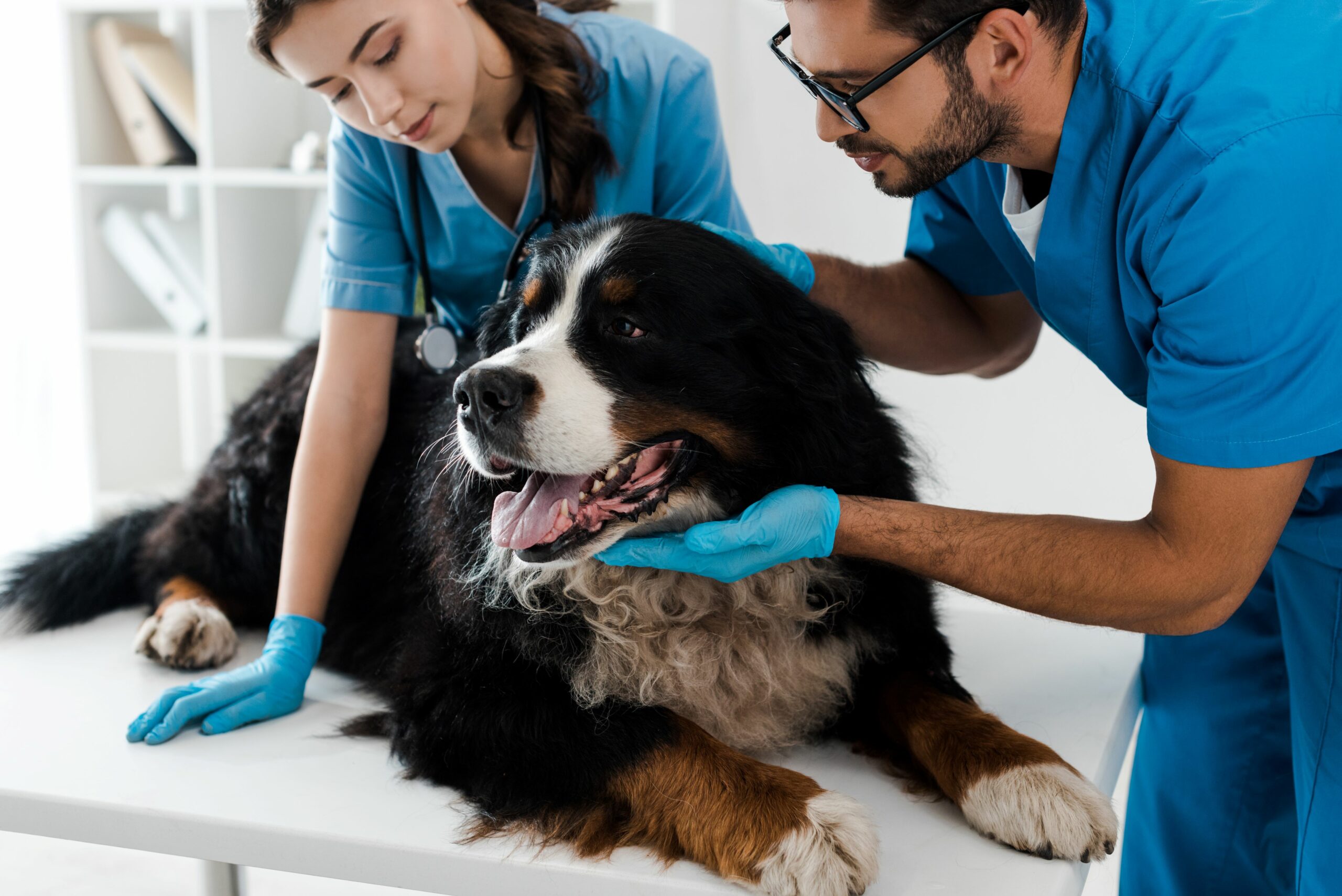Jul 18, 2024

Bloat describes when a dog’s stomach rapidly overfills with food and gas and twists on itself. Medically this is referred to as gastric dilatation and volvulus (GDV). At any given time, a dog’s stomach contains a variable amount of food and gas. Digestive enzymes break down food, and gas may either travel backward through the esophagus as a burp or move forward through the rest of the gastrointestinal tract. However, with enough static food and gas, the stomach can bloat (dilatation), expanding far beyond a normal size. A bloated stomach can then twist upon itself (volvulus), trapping the food and gas within. The twisting cuts off the circulation to the stomach and is a life-threatening emergency that requires veterinary care ASAP.
We don’t know why exactly GDV occurs, but we do know several risk factors. For example, purebred dogs are 1.5-4.8 times more likely to suffer from GDV(1). Other risk factors include:
There are also certain types of dogs that are at increased risk for developing GDV:
Deep-chested dogs – where the chest length from sternum to backbone is markedly longer than chest width – are particularly at risk. Although many dog breeds can suffer from GDV, we can pinpoint specific deep-chested dog breeds that are overrepresented:
The most common signs of GDV are:
If your dog shows any of the above signs, seek emergency veterinary care immediately. Damage to a twisted stomach increases with time, so the faster your dog receives care, the better the prognosis. There is unfortunately a clear correlation between treatment delay and mortality in these cases.(2) It is more common for dogs to show signs of GDV later in the evening, well after primary care vet clinics close, compared to other times of the day.(3) AESC’s Emergency Service is open 24/7.
An x-ray of the belly is a fast and reliable way to confirm a diagnosis of GDV. Other tests, such as blood work and EKG, are also performed to look for metabolic derangements and cardiac arrhythmias (abnormal heart rhythm) that are common complications of the condition.

This x-ray shows a bloated, twisted stomach in a dog experiencing GDV.
Emergency surgery is necessary to untwist the stomach. However, dogs with GDV are high-risk anesthetic candidates, and so before surgery occurs, initial stabilization is important. This entails intravenous (IV) fluids and stomach decompression. Decompression of the stomach releases entrapped gas by passing a catheter through the side of the abdomen. GDV is a painful condition, and so pain medications will also be administered, even before surgery occurs. Cardiac arrhythmias are treated with medications to stabilize the heart. In some more severe cases, bacteria from inside the gastrointestinal tract start to gain access to the systemic circulation, causing sepsis. These patients require additional treatments such as glucose supplementation and blood pressure support.
Anesthesia for GDV surgery requires a skilled and experienced team. Complications like cardiac arrhythmias, low blood pressure, and pain can be successfully recognized and addressed with proper monitoring equipment, techniques, and medications. Larger veterinary hospitals like AESC are well-equipped for these types of cases. Our board-certified anesthesiologist trains our anesthetists and ensures we have everything necessary to successfully anesthetize even the sickest of patients.
During surgery, it may be noted that the prolonged lack of blood flow to the stomach has caused parts of it to die and need to be removed. Other organs, like the spleen, can twist along with the stomach and need to be removed as well. Dogs can live without a spleen and parts of their stomach, but these surgeries have a higher risk of complications. Once the stomach is untwisted and returned to the normal position, it will be tacked, or permanently affixed, to the side of the abdomen in a procedure called gastropexy. Although gastropexy will not prevent bloating from happening after a large meal, it is highly successful in preventing stomach twisting. With gastropexy, the risk for GDV recurrence drops from about 80% down to less than 5%.(4)
Postoperatively, patients will need careful monitoring, continued IV fluid therapy, and pain management. At AESC, these postoperative patients are cared for by the Critical Care service, a team of veterinary specialists with extensive knowledge and experience in treating patients with the most complicated, life-threatening illnesses.
Studies report a survival rate after GDV surgery between 85-90%.3,4 Interestingly, one study found significantly better outcomes when surgery specialists performed the surgery, particularly in more serious cases where the spleen and/or parts of the stomach needed to be removed.(3) That newer studies report better success is likely due to advances in veterinary medicine and an increasing prevalence of advanced veterinary hospitals like AESC that have trained specialists in surgery, anesthesia, and critical care.
The most effective way to prevent GDV is to pursue elective gastropexy, or stomach tacking surgery, in dogs who have an increased risk of developing the condition. This surgery can be performed at the time of spay or neuter. There are enormous advantages to prophylactic gastropexy surgery:
The board-certified surgeons at AESC all perform laparoscopic gastropexy, in addition to traditional gastropexy and emergency GDV correction surgery. If you are interested in learning more about prophylactic gastropexy surgery at AESC, please contact us to schedule a surgery consultation.

One of our board-certified surgeons performing elective laparoscopic gastropexy.

Food bowls like these can slow down eating, potentially reducing the risk of bloat and GDV.
1. https://www.acvs.org/small-animal/gastric-dilatation-volvulus/
2. Song K et al. Retrospective analysis of 736 cases of canine gastric dilatation and volvulus. Aust Vet J. 2020 98(6):232-238.
3. Allen P and Paul A. Gastropexy for prevention of gastric dilatation- volvulus in dogs: history and techniques. Top Companion Anim Med. 2014 29(3):77-80.
4. Mackenzie G et al. A retrospective study of factors influencing survival following surgery for gastric dilatation-volvulus syndrome in 306 dogs. J Am Anim Hosp Assoc. 2010 46(2):97-102.
5. Vega M and Ralphs C. Outcomes and complications of prophylactic incisional gastropexy in 766 dogs (2009-2019). BMC Res Notes 2023 31;16(1):300